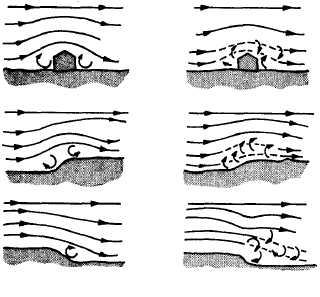Vertical eddies are generally found on the lee side
of mountains, but with low wind speeds, stationary
eddies or rotating pockets of air are produced and
remain on both the windward and leeward sides of
obstructions. (See figure 3-29.) When wind speeds
exceed about 20 knots, the flow may be broken up into
irregular eddies that are carried along with a wind some
distance downstream from the obstruction. These
eddies may cause extreme and irregular variations in
the wind and may disturb aircraft landing areas
sufficiently to be a hazard.
A similar and much disturbed wind condition
occurs when the wind blows over large obstructions
such as mountain ridges. In such cases the wind
blowing up the slope on the windward side is usually
relatively smooth. On the leeward side the wind spills
rapidly down the slope, setting up strong downdrafts
and causing the air to be very turbulent. This condition
is illustrated in figure 3-30. These downdrafts can be
very violent. Aircraft caught in these eddies could be
forced to collide with the mountain peaks. This effect is
also noticeable in the case of hills and bluffs, but is not
as pronounced.
Turbulence
Turbulence
is
the
irregular
motion
of
the
atmosphere caused by the air flowing over an uneven
surface or by two currents of air flowing past each other
in different directions or at different speeds. The main
source of turbulence is the friction along the surface of
Earth. This is called mechanical turbulence. Turbulence
is also caused by irregular temperature distribution.
The warmer air rises and the colder air descends,
causing an irregular vertical motion of air; this is called
thermal turbulence.
Mechanical turbulence is intensified in unstable air
and is weakened in stable air. These influences cause
fluctuations in the wind with periods ranging from a
few minutes to more than an hour. If these wind
variations are strong, they are called wind squalls and
are usually associated with convective clouds. They are
an indication of approaching towering cumulus or
cumulonimbus clouds.
Gustiness
and
turbulence
are
more
or
less
synonymous. Gustiness is an irregularity in the wind
speed that creates eddy currents disrupting the smooth
airflow. Thus, the term gust is usually used in
conjunction with sudden intermittent increases in the
wind speed near the surface levels. Turbulence, on the
other hand, is used with reference to levels above the
surface. Gustiness can be measured; turbulence,
however, unless encountered by aircraft equipped with
a gust probe or an accelerometer, is usually estimated.
Large-Scale Vertical Waves (Mountain Waves)
Mountain waves occur on the lee side of
topographical barriers and occur when the wind-flow is
strong, 25 knots or more, and the flow is roughly
perpendicular to the mountain range. The structure of
the barrier and the strength of the wind determines the
3-27
AG5f0329
LOW WIND SPEED
(BELOW 20 MPH)
HIGH WIND SPEED
(ABOVE 20 MPH)
Figure 3-29.—Eddy currents formed when wind flows over
uneven ground or obstructions.
AG5f0330
WINDWARD
LEEWARD
WIND
Figure 3-30.—Effect of windflow over mountains.




